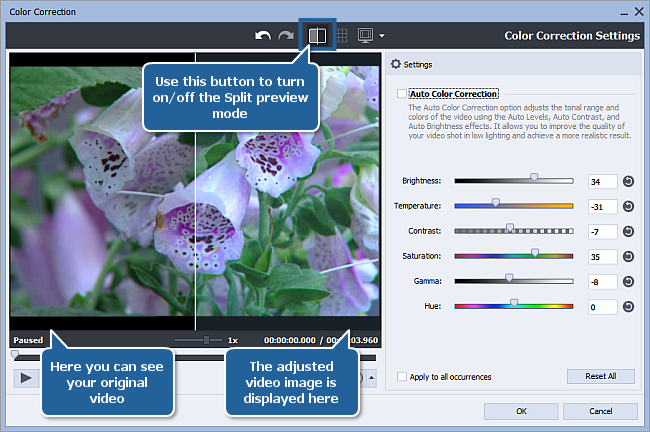It might happen that after shooting your home video with an analog camera or after capturing video from an old VHS tape, the captured video image has mainly blue and purple colors. You can easily correct colors in your video using the AVS Video Editor program.
Please read the How to start working with AVS Video Editor? guide to learn how to download and install the application, import your video and add it to the timeline.
After the video you want to edit is put on the timeline, please follow the steps below to make the necessary color adjustments thus correcting color in your video.
If you added several video clips to the timeline, you should highlight the video needed to be edited by left-clicking it. Then hit the Color button located above the Timeline to open the Color Correction window.
 Note
Note: if you don't see the
Color button, click the
More Options button and select the
Color option from the list.

[Back to the Top]
After clicking the Color button, the Color Correction window will be opened, where you can adjust color settings.
Select the Auto Color Correction option which includes the Auto Levels, Auto Contrast and Auto Brightness effects to apply automatic adjustments to your video.

If you don't want to correct color automatically, you can adjust it manually. On the right hand there are six parameters available for changing (if the Auto Color Correction box is unchecked):
Brightness - is used to customize the overall lightness or darkness of your video image. This setting lets you make simple adjustments to the tonal range of your video.
Temperature - is used if the tints of blue dominate in your video. This setting lets you adjust your video image to warm (or if necessary cold) colors.
Contrast - is used to change the degree of difference in brightness between the darkest and lightest parts of the video image.
Saturation - is used to make colors of the entire video image look more saturated or inconspicuous. This setting represents the amount of gray in proportion to the hue.
Gamma - is used to correct gray intensities in the video. Black keeps black and white keeps white. It measures the brightness of midtone values and modifies the pixel values in the video image. A higher gamma value yields an overall lighter image.
Hue - is used to adjust the hue of the entire image. The hue, or color, adjustment represents a move around the color wheel. Hue is the color reflected from or transmitted through an object. It is measured as a location on the standard color wheel, expressed as a degree between 0° and 360°. In common use, hue is identified by the name of the color such as red, orange, or green.

You can adjust the color correction settings by directing your mouse cursor to the indicator, left-clicking it and moving it to the left or right along the slider. After releasing the left mouse button, the respective value will be set. You can immediately see the result in the Preview Area.
If you don't like the result, you can always click the appropriate  button to reset any setting to its original value. Or press the Reset All button at the bottom of the window to discard all the changes made to the colors in your video. It's also possible to use the Redo and Undo buttons for this purpose.
button to reset any setting to its original value. Or press the Reset All button at the bottom of the window to discard all the changes made to the colors in your video. It's also possible to use the Redo and Undo buttons for this purpose.
If you press the Split preview button located on the top of the Color Correction window, the preview screen will be divided into two parts. The original video image without correction will be displayed on the left side and at the same time the adjusted video will be shown on the right side. To disable this option press the Split preview button once again.

[Back to the Top]
As soon as everything is done in order to correct color in your video, you can preview the edited file to make sure you got the necessary result. Please, press the  button within the Preview Area of the same window to start playback.
button within the Preview Area of the same window to start playback.

If you are completely satisfied with the result, click the OK button to accept all the changes and close the Color Correction window. Then you can save the current project, as well as the edited video file into one of the supported formats. To learn more about it, read the How to save the project and the video in AVS Video Editor? guide.
[Back to the Top]
Please note that AVS4YOU programs do not allow you to copy protected material. You may use this software in copying material in which you own the copyright or have obtained permission to copy from the copyright owner.